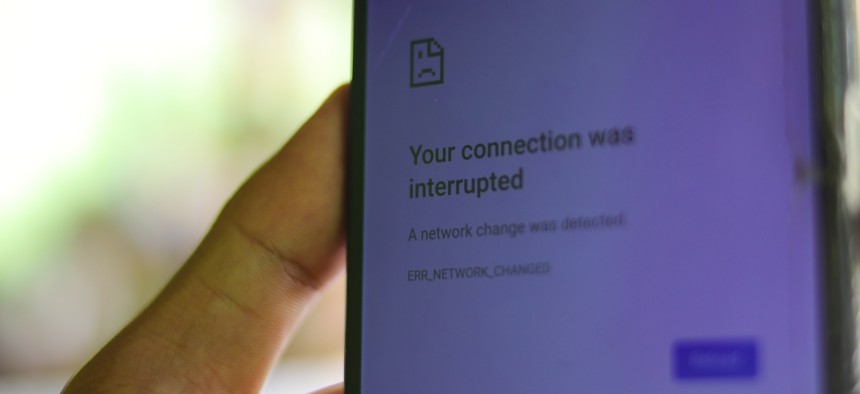Broadband map challenges underway despite ‘flawed’ process

Jamaludin Yusup/Getty Images
Filing challenges is onerous and relies too much on crowdsourced data, observers say.
After a town hall meeting about broadband availability in southern Mississippi, Scott Woods, vice president of community engagement at broadband grant matchmaker Broadband.Money, said he was approached by an attendee who was “perplexed.”
Woods said the attendee noted that despite the advances in algorithms and advanced technologies, when it comes to mapping the availability of broadband internet in the United States, government agencies “take [internet service providers’] word that this is what we have.”
Those states, cities and residents who don’t want to just accept broadband availability coverage data from ISPs and the Federal Communications Commission have just weeks to put together their challenges to the first round of the FCC’s new broadband availability maps. Successful challenges will rely heavily on community members to go online, confirm whether a location is able to connect to broadband and if the speeds available on the map reflect reality and follow a challenge process if it does not.
Already, some experts have said that states could be hamstrung without large GIS-trained staff to spot errors and make a robust challenge. Some local governments have already asked for more time to conduct their own analysis ahead of the Jan. 13, 2023, challenge deadline. Woods said he has heard from people across the U.S. who said they are are “disappointed” both in the maps and in the challenge process, which are both “flawed.”
“The challenge process is nonsensical,” Woods said. “They're only doing address-level and coverage challenges right now. But it's so difficult for an individual to comprehend and submit a challenge that it's a self-defeating process.”
Outside groups also raised significant questions about the underlying data in the FCC’s map, leaving some to wonder if the challenge process will be enough to correct it.
In a letter to FCC Chairwoman Jessica Rosenworcel, two advocacy groups representing over 100 public sector and community organizations, raised concerns around the map’s lack of information about broadband availability in anchor institutions like libraries and schools.
The groups also said the map also does too little to show the full extent of broadband in multifamily residential housing, and it places too much onus on people that may lack the resources to submit a challenge. It is “naïve and unfair that millions of unserved households located in high-poverty areas” should be responsible for mounting a challenge, even with the help of “benevolent third party entities,” the letter said.
FCC spokespeople did not respond to requests for comment on the challenge process, but in a blog post last month when the new maps were released, Rosenworcel called the maps a “beginning, not an endpoint” for the process and urged governments and individuals “to partner with us and share their input through the challenge process.”
Governments and elected officials have encouraged their constituents to get involved. For example, Travis County, Texas, issued an open call for locals to “review, verify and improve” the map. Rondella Hawkins, telecommunications and regulatory affairs officer for Austin, said in an accompanying statement that this “crowdsourcing approach is an ideal way” to assess service.
Woods urged everyone to participate in the challenge process, but he expressed hope that there will soon be a recognition among federal agencies and Congress that the maps are still flawed. With that acknowledgment, which may need to be prompted by further “advocacy on the back end,” Woods said he hopes for “some leniency and understanding” from appropriators on how much money they distribute.
National groups have offered guidance to state and local governments looking to follow in the footsteps of New York and others and challenge the FCC’s data. The National League of Cities recently posted guidance outlining how cities can navigate the challenge process, directing leaders to the FCC’s handbook on how to mount a challenge.
An NLC spokesperson noted that the organization’s digital equity playbook released last year can also help local leaders determine whether they need to submit a challenge. It includes community-level metrics on unserved and underserved residents, and vendor-provided data shows the community’s average internet download speed, average internet upload speed and households without internet access.
For its part, the FCC also released information to internet service providers on how to respond to availability challenges made against fixed internet service.
In the end, Dustin Loup, a program manager at the National Broadband Mapping Coalition, said there is “no established process” around what the FCC will do with the challenge data it receives from states, localities and individuals.
“The crowdsource process basically says [the FCC] can use it if they want to; there's no threshold at which they're required to use it,” Loup said. “And there's no established timeline for review when they do choose to act upon crowdsourced data that's been submitted.”
Additionally, the map and challenge data being collected only reflects part of what is happening on the ground when it comes to broadband availability and access. The methodology of data collection must also reflect factors like available speeds and the socioeconomic factors that may prevent people from paying for the services on offer. Factoring in those when considering broadband availability is important, Woods said, as “that’s where the real rubber meets the road.”
NEXT STORY: Machine learning digs into states’ archives






